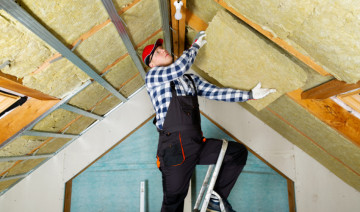
The Contractor's Guide to Insulating Attics and Roofs
Proper insulation is crucial for maintaining energy efficiency and comfort in residential and commercial buildings. When it comes to insulating attics and roofs, contractors play a vital role in ensuring effective insulation installation. In this blog post, we'll provide a comprehensive guide for contractors on insulating attics and roofs, covering key considerations, insulation materials, and best practices.
- Assessing the Attic and Roof: Before starting any insulation project, it's important to conduct a thorough assessment of the attic and roof. This includes checking for any existing insulation, identifying air leaks, inspecting for moisture or mold issues, and evaluating the overall condition of the roof structure.
- Choosing the Right Insulation Material: Discuss the various insulation materials suitable for attic and roof applications, such as fiberglass batts, blown-in cellulose, spray foam, and rigid foam boards. Explain the pros and cons of each material, considering factors like R-value, moisture resistance, air sealing properties, and compatibility with the specific project requirements.
- Understanding R-Value and Building Codes: Explain the concept of R-value, which measures the thermal resistance of insulation. Discuss the importance of adhering to local building codes and energy efficiency standards when determining the required R-value for the attic and roof insulation. Provide guidance on calculating the appropriate R-value based on climate zone and project specifications.
- Air Sealing and Vapor Barriers: Highlight the significance of air sealing in attic and roof insulation projects. Discuss the importance of sealing gaps, cracks, and openings to prevent air leakage and heat loss. Explain the role of vapor barriers in managing moisture and condensation within the insulation system.
- Installation Best Practices: Provide step-by-step instructions and best practices for installing attic and roof insulation. Discuss techniques for insulating different areas, such as attic floors, roof rafters, and cathedral ceilings. Cover topics like proper insulation placement, ensuring adequate ventilation, and maintaining clearances around fixtures and equipment.
- Safety Considerations: Emphasize the importance of safety during insulation installation. Discuss the use of personal protective equipment (PPE), such as gloves, goggles, and masks, to protect against insulation fibers or fumes. Provide tips for working in confined spaces and handling insulation materials safely.
- Post-Installation Inspections and Quality Assurance: Highlight the significance of post-installation inspections to ensure the insulation is properly installed and meets the desired performance standards. Discuss methods for identifying and rectifying any gaps, voids, or compression in the insulation. Encourage thorough quality assurance checks to deliver a high-quality, well-insulated attic and roof.
Insulating attics and roofs is a critical task for contractors, contributing to energy efficiency, comfort, and overall building performance. By following this comprehensive guide, contractors can successfully navigate the process of assessing, choosing materials, installing, and ensuring the quality of insulation in attics and roofs. Properly insulated spaces not only benefit homeowners and building occupants but also help contractors deliver exceptional results and build a reputation for excellence in their industry.
